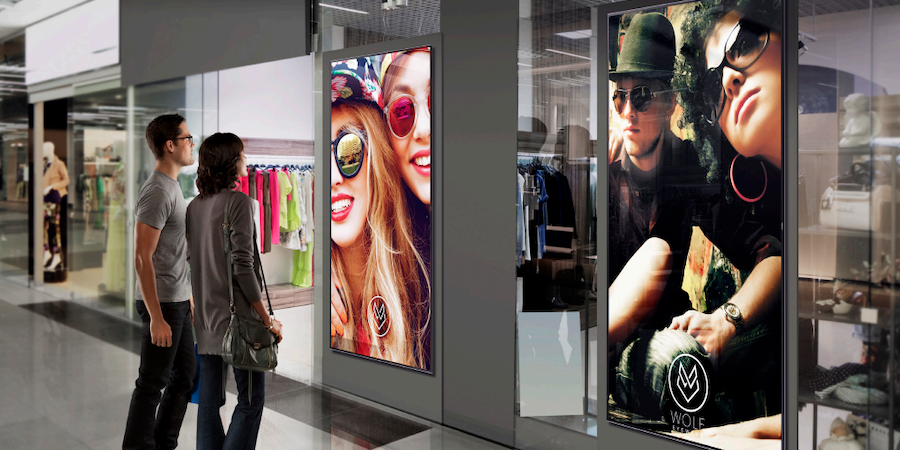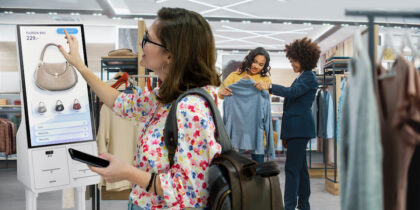Today’s consumers expect personalized shopping experiences, both in store and online. People want to be treated as individuals, with store communications, products and offers tailored uniquely to them.
With proprietary first-party consumer data, retailers can create immersive, customized shopping experiences — which ultimately enables retailers to connect with individual shoppers, then inspire those customers to return to the brands they love.
Digitization trend
Over the last two years, contactless checkout and buy online, pick up in store (BOPIS) have become commonplace, enabled by new online ordering apps. BOPIS sales in the U.S. ballooned from $23.42 billion in 2018 to $64.56 billion just three years later. In 2022, those sales are anticipated to reach $74.24 billion.
Many retailers adopted digital signage to inform their in-person customers about where to pick up items in-store or to educate them about health safety protocols, but displays are also being leveraged to allow consumers to self-educate and play. Interactive displays and in-store automation are filling customer support needs as retailers navigate a pandemic-induced global labor shortage.
But as for what to share on these apps and displays, many stores have struggled to leverage their content in a meaningful way or maximize the technology’s return on investment (ROI).
First-party data — the firsthand information a retailer has about their customers — is the solution today’s retailers need to improve their marketing and enhance the customer journey. With valuable information such as customers’ purchase history, first-party data allows retailers to know their customers as individuals and create personalized marketing communications that are delivered in real time.
The future of retail is digital
Get your free guide to growing your retail business by adopting future-proof, ecommerce technology. Download Now
Retailers own this data. As they collect it directly from customers, first-party data is more relevant and accurate than second- or third-party data, which comes from outside sources that don’t have a direct relationship with your customers.
First-party data opportunity
Samsung is working with its retail partners to strengthen the role of first-party consumer data, including data captured through social media and loyalty channels, in brick and mortar stores. By gathering all the information they have about their customers into one centralized location, retail brands get a unified view of their unique audience.
The vast majority of U.S. marketers value first-party customer data, with 80 percent agreeing this information is strategically important. Compared to other data types, first-party consumer data provides the highest ROI; two-thirds of marketers believe this information provides the best path to truly understanding your customers and improving your brand’s overall performance.
Online, retailers can track their shoppers’ browsing history and analyze first-party data to win audience insights, such as their likes and dislikes. This information allows for more personalized marketing content and ads based on your customers’ behavior and needs.
Similarly, brick and mortar retailers can understand anonymous, aggregated customer journeys as they move through their stores, just like they do on a retailer’s website. AI-driven sensors and heat mapping allow retailers to measure and understand their conversion funnel from walkby to purchase. This includes where consumers spend the most time, as well as which products win their attention and which ones don’t.
With this data, alongside the ability to trigger digital displays, retailers can impact and drive a more productive journey. On-shelf displays can also be updated with timely and relevant messaging, such as discount codes, shopper reviews, brand insights and suggested complementary items. The same data allows retailers to identify underperforming “cool” spots, then make strategic changes to turn them into must-visit hot spots, optimizing their store layout to strategically showcase their latest inventory and offers.
Consumer data in action
In-store purchasing data can provide insights into customers’ buying habits and product preferences, while omnichannel consumer data — from in-store, desktop and mobile shopping — can help build fully informed and well-rounded customer profiles. Loyalty programs and social media are also rich sources of first-party consumer data, such as customer feedback, insights and interests.
Panico Salon, a luxury hair salon and spa in New Jersey, is using their consumer data to personalize their visitors’ experience via their interactions with new digital displays, both inside and outside the salon. At the entrance, for example, a Samsung QMR display shares a personalized welcome message whenever someone arrives for their appointment.
Inside, AI data sensors capture how customers make their way through the salon and how they interact with products. In the salon’s retail shopping area, if a customer picks up a particular product, motion sensors alert the nearest display to share product information and promotional videos. Panico is also deploying FastSensor AI, which uses AI sensors to monitor foot traffic in front of and inside the location. This allows a retailer to develop a conversion funnel and determine how long customers linger in specific areas of the salon.
Social media integrations
Social media within retail is a key focus area for Samsung, and poised to be a big activation for us in 2022. Research from Gartner shows that social media now plays a critical role throughout the customer journey, and 82 percent of the U.S. population currently uses social media. Digital marketing leaders can make their marketing efforts more efficient by communicating with customers across social channels throughout the entire shopper journey.
One national retail brand has partnered with Samsung and social listening company Sprinklr to capture social impressions. The interactive technology invites customers to visit a selfie station inside the store and take a photo, which they share with their friends and with the brand, giving the retailer permission to post their photo on social media and add them to an in-store collage. The initiative proves social media can work both inbound and outbound from brick and mortar, and that it’s an innovative tactic to introduce social branding in store while building customer loyalty.
Programmatic advertising
By leveraging their first-party customer data through in-store advertising programs like digital displays, retailers can drive new revenue streams. Informed by accurate data and reporting, retail ad campaigns are much more likely to reach their intended audience — with content that’s both timely and relevant. Brands like Duty Free Americas share their in-store customer traffic data with product vendors, who pay to have their product videos displayed in certain areas of the store at certain times.
It’s a win-win scenario for retail brands: Personalized in-store experiences are more engaging and compelling to customers, while ad buyers — typically a retailer’s key suppliers — can appreciate this precisely targeted approach to advertising slots and scheduling, and will attach a premium to it.
Data tells a story
First-party consumer data provides retailers with the highest-quality insights into their target audience and allows stores to provide more personalized experiences that enhance the shopper journey. Savvy retailers can use their first-party data to nurture existing customers into lifelong customers and increase customer lifetime value.
Discover more innovative signage options for all your brand’s in-store marketing needs from Samsung’s full lineup of retail display solutions. And find everything you need to know about choosing your LED displays for optimal viewing indoors and out in our free ultimate guide to LED.








